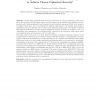IACR
2016
8 years 7 months ago
2016
IACR
2016
8 years 7 months ago
2016
Cryptographic security is usually defined as some form of guarantee that holds except when a bad event with negligible probability occurs, and nothing is guaranteed in that case. ...
IACR
2016
8 years 7 months ago
2016
Abstract. We study the use of known, well-connected network topology, to improve key setup and management. Specifically, we present the TopKeyS protocol, that uses such known-topo...
IACR
2016
8 years 7 months ago
2016
Cayley hash functions are based on a simple idea of using a pair of (semi)group elements, A and B, to hash the 0 and 1 bit, respectively, and then to hash an arbitrary bit string i...
IACR
2016
8 years 7 months ago
2016
We construct an algorithm that permits a large group of individuals to reach consensus on a random number, without having to rely on any third parties. The algorithm works with hi...
IACR
2016
8 years 7 months ago
2016
In PKC 2014, Dachman-Soled showed a construction of a chosen ciphertext (CCA) secure public key encryption (PKE) scheme based on a PKE scheme which simultaneously satisfies a secu...
IACR
2016
8 years 7 months ago
2016
IACR
2016
8 years 7 months ago
2016
We investigate how to safely export additional cryptographic keys from secure channel protocols, modelled with the authenticated and confidential channel establishment (ACCE) secu...
IACR
2016
8 years 7 months ago
2016
Recently, Farasha et al. proposed an efficient user authentication and key agreement scheme for heterogeneous wireless sensor network tailored for the Internet of Things environme...
IACR
2016
8 years 7 months ago
2016
In this document we present an overview of the background to and goals of the Password Hashing Competition (PHC) as well as the design of its winner, Argon2, and its security requi...




